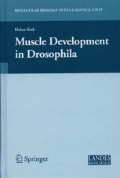Abstract
With the development of microarray technology, and other whole genome approaches, it is now possible to systematically screen an entire genome for genes that are differentially expressed during two different stages of development and/or two different types of cells. This can be readily applied to muscle development by using genetic manipulations that either overexpress a key gene during development, or by using loss-of-function mutants. This chapter describes the genomic approaches that can be used to identify the vast majority (if not all) of the genes that are normally expressed in muscle cells, and can give an indication of their function during muscle development. These approaches include microarray analysis (transcriptome analysis), RNAi screens (phenome mapping), protein localization studies (localizome mapping), and protein-protein interaction studies (interactome mapping). As microarray analysis is the genomic approach that has been applied the most extensively to Drosophila muscle development, the main emphasis of this chapter will be on gene expression profiling during muscle development.
Access this chapter
Tax calculation will be finalised at checkout
Purchases are for personal use only
Preview
Unable to display preview. Download preview PDF.
References
Furlong EE, Profits D, Scott MP. Automated sorting of live transgenic embryos. Nat Biotechnol 2001; 19(2):153–156.
Arbeitman MN, Furlong EE, Imam F et al. Gene expression during the life cycle of Drosophila melanogaster. Science 2002; 297(5590):2270–2275.
Furlong EE, Andersen EC, Null B et al. P atterns of gene expression during Drosophila mesoderm development. Science 2001; 293(5535):1629–1633.
Thisse B, el Messal M, Perrin-Schmitt F. The twist gene: Isolation of a Drosophila zygotic gene necessary for the establishment of dorsoventral pattern. Nucleic Acids Res 1987; 15(8):3439–3453.
Leptin M, Grunewald B. Cell shape changes during gastrulation in Drosophila. Development 1990; 110(1):73–84.
Borkowski OM, Brown NH, Bate M. Anterior-posterior subdivision and the diversification of the mesoderm in Drosophila. Development 1995; 121(12):4183–4193.
Baylies MK, Bate M. Twist: A myogenic switch in Drosophila. Science 1996; 272(5267):1481–1484.
Artero R, Furlong EE, Beckett K et al. Notch and ras signaling pathway effector genes expressed in fusion competent and founder cells during Drosophila myogenesis. Development 2003; 130(25):6257–6272.
Li S, Xu C, Carthew RW. Phyllopod acts as an adaptor protein to link the sina ubiquitin ligase to the substrate protein tramtrack. Mol Cell Biol 2002; 22(19):6854–6865.
Li S, Li Y, Carthew RW et al. Photoreceptor cell differentiation requires regulated proteolysis of the transcriptional repressor tramtrack. Cell 1997; 90(3):469–478.
Pi H, Wu HJ, Chien CT. A dual function of phyllopod in Drosophila external sensory organ development: Cell fate specification of sensory organ precursor and its progeny. Development 2001; 128(14):2699–2710.
Tang AH, Neufeld TP, Kwan E et al. PHYL acts to down-regulate TTK88, a transcriptional repressor of neuronal cell fates, by a SINA-dependent mechanism. Cell 1997; 90(3):459–467.
Tenenbaum SA, Carson CC, Lager PJ et al. Identifying mRNA subsets in messenger ribonucleoprotein complexes by using cDNA arrays. Proc Natl Acad Sci USA 2000; 97(26):14085–14090.
Roy PJ, Stuart JM, Lund J et al. Chromosomal clustering of muscle-expressed genes in Caenorhabditis elegans. Nature 2002; 418(6901):975–979.
Kamath RS, Fraser AG, Dong Y et al. Systematic functional analysis of the Caenorhabditis elegans genome using RNAi. Nature 2003; 421(6920):231–237.
Misquitta L, Paterson BM. Targeted disruption of gene function in Drosophila by RNA interference (RNA-i): A role for nautilus in embryonic somatic muscle formation. Proc Natl Acad Sci USA 1999; 96(4):1451–1456.
Balagopalan L, Keller CA, Abmayr SM. Loss-of-function mutations reveal that the Drosophila nautilus gene is not essential for embryonic myogenesis or viability. Dev Biol 2001; 231(2):374–382.
Kim YO, Park SJ, Balaban RS et al. A functional genomic screen for cardiogenic genes using RNA interference in developing Drosophila embryos. Proc Natl Acad Sci USA 2004; 101(1):159–164.
Lum L, Yao S, Mozer B et al. Identification of hedgehog pathway components by RNAi in Drosophila cultured cells. Science 2003; 299(5615):2039–2045.
Kiger A, Baum B, Jones S et al. A functional genomic analysis of cell morphology using RNA interference. J Biol 2003; 2(4):27.
Caplen NJ, Fleenor J, Fire A et al. dsRNA-mediated gene silencing in cultured Drosophila cells: A tissue culture model for the analysis of RNA interference. Gene 2000; 252(1–2):95–105.
Wei Q, Marchler G, Edington K et al. RNA interference demonstrates a role for nautilus in the myogenic conversion of Schneider cells by daughterless. Dev Biol 2000; 228(2):239–255.
Huh WK, Falvo JV, Gerke LC et al. Global analysis of protein localization in budding yeast. Nature 2003; 425(6959):686–691.
Ghaemmaghami S, Huh WK, Bower K et al. Global analysis of protein expression in yeast. Nature 2003; 425(6959):737–741.
Morin X, Daneman R, Zavortink M et al. A protein trap strategy to detect GFP-tagged proteins expressed from their endogenous loci in Drosophila. Proc Natl Acad Sci USA 2001; 98(26):15050–15055.
Gavin AC, Bosche M, Krause R et al. Functional organization of the yeast proteome by systematic analysis of protein complexes. Nature 2002; 415(6868):141–147.
Reboul J, Vaglio P, Rual JF et al. C. elegans ORFeome version 1.1: Experimental verification of the genome annotation and resource for proteome-scale protein expression. Nat Genet 2003; 34(1):35–41.
Giot L, Bader JS, Brouwer C et al. A protein interaction map of Drosophila melanogaster. Science 2003; 302(5651):1727–1736.
Wang L, Fan C, Topol SE et al. Mutation of MEF2A in an inherited disorder with features of coronary artery disease. Science 2003; 302(5650):1578–1581.
Schott JJ, Benson DW, Basson CT et al. Congenital heart disease caused by mutations in the transcription factor NKX2-5. Science 1998; 281(5373):108–111.
Author information
Authors and Affiliations
Rights and permissions
Copyright information
© 2006 Eurekah.com and Springer Science+Business Media
About this chapter
Cite this chapter
Furlong, E.E.M. (2006). Whole Genome Approaches to Studying Drosophila Muscle Development. In: Muscle Development in Drosophila. Molecular Biology Intelligence Unit. Springer, New York, NY. https://doi.org/10.1007/0-387-32963-3_13
Download citation
DOI: https://doi.org/10.1007/0-387-32963-3_13
Publisher Name: Springer, New York, NY
Print ISBN: 978-0-387-30053-5
Online ISBN: 978-0-387-32963-5
eBook Packages: Biomedical and Life SciencesBiomedical and Life Sciences (R0)

